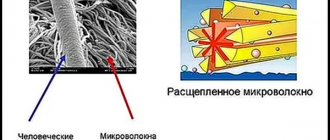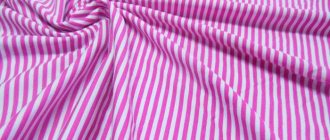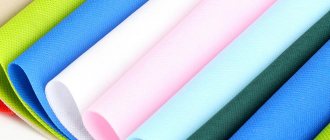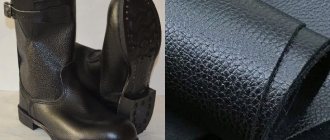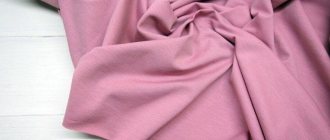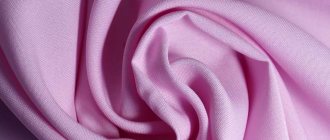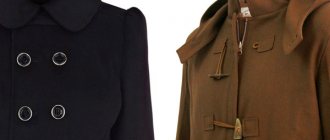What is it - lavsan
Lavsan is a synthetic material made from petroleum products, one of the types of thermoplastic. Belongs to the group of polyester fibers. The chemical name of the fiber is polyethylene terephthalate.
Polyesters are high molecular weight compounds in which the molecules are joined in complex groups. Polyethylene terephthalate is the most commonly used of the polyesters. The molecules of the substance are rigid and have a highly elongated shape.
Dacron fibers look like threads with a smooth surface, round cross-section, and slight shine. The thickness of the thread depends on its purpose.
Characteristics of lavsan:
- Hygroscopicity. Low: Dacron is waterproof. It does not deform and does not change properties in water.
- Form stability. Lavsan does not shrink when exposed to high temperatures.
- Elasticity. Elasticity is high. The fibers stretch and then return to their original shape.
- Resistant to chemicals such as acid, organic solvents and alkalis.
- UV resistance. High.
- Strength. High: the fabric is resistant to tearing and physical impact.
- Thermal insulation properties. High: the material retains heat.
- Breathability. Low.
- Combustion reaction. A white flame and black soot are formed.
- Antibacterial properties. Mylar fibers do not have suitable conditions for the development of fungi and bacteria.
- Difficulty in coloring. Lavsan does not absorb dyes well. Therefore, it can be painted only with the help of chemicals.
Dacron fiber was first invented in 1935 in Great Britain. In Russia, the development of polyethylene terephthalate was carried out by the scientist Aizenstein at the Laboratory of Macromolecular Compounds of the USSR Academy of Sciences.
By the way, the material is called lavsan only in the CIS countries; in other countries it is known under the names dacron, tergal, terylene.
To obtain lavsan, oil is used, which is repeatedly processed in different ways. As a result, ethylene glycol is obtained and combined with terephthalic acid. The resulting polymers are melted and passed through special fillers (tiny holes).
The resulting fibers are so thin that they resemble a spider's web. When hot they stick together. This produces a thread that is wound onto a bobbin or used to weave fabrics. The thickness of the thread depends on the diameter of the fillers and the number of glued fibers.
Nylon and polyethylene terephthalate belong to the same group. You can distinguish lavsan from nylon by burning. The first material will produce black soot, while the other will produce an unpleasant odor without soot.
The cost of the simplest fabric options starts from 200 rubles per meter.
Watch educational program:
Types of fabric
Mylar fibers are used to produce fabrics. They come in the following types:
- Homogeneous. This material is exclusively made from lavsan. Such fabrics are used to make linings or outer layers of outerwear, umbrellas, decorative home textiles, etc.
- Cotton. A mixture of cotton and lavsan (the latter is present in smaller quantities). Thanks to this composition, the fabric does not shrink when washed, allows air to pass through, absorbs moisture, and is durable and strong. It is used for sewing casual, home clothes, bed linen.
- Woolen. Mylar fibers are also often added to woolen threads. This reduces the cost of the finished product, makes it more durable, and protects it from deformation when wet. The fabric is used for sewing suits.
- Viscose. The fabric, which combines lavsan synthetic fiber and semi-natural viscose, is pleasant to wear, soft to the touch, and durable. Used for sewing everyday clothes.
Application of lavsan
In what sectors of industry and national economy is lavsan not used due to its unique properties? It is in particular demand in the textile industry for the production of sewing threads, curtains and tulle fabrics, decorative fabrics and artificial fur. Dacron fabric is successfully used in the production of outerwear, shirts, suits, dresses, etc.
The insulating properties of this material make it indispensable in the electrical industry. Fire hoses and hoses for irrigation machines made from lavsan do not rot and have a very long service life.
Dacron is in increasing demand in medicine. It is used as a substitute for blood vessels. In surgery, lavsan thread is increasingly replacing the usual one.
Polyethylene terephthalate is most widely used in the production of food films, plastic containers and bottles. In addition, this is the most important component in the manufacture of modern storage media (disks, photographic films, magnetic tapes).
Today the chemical industry, medical industry and mechanical engineering cannot do without the use of lavsan. It is used in the manufacture of household appliances, food equipment, and conveyor belts. Filling polyethylene terephthalate with various additives (fiberglass, fluoroplastic, molybdenum disulfide) significantly improves its mechanical and electrical properties. It is difficult to name an area of production today where lavsan is not used. What it is and what properties it has was discussed in detail in the article.
Advantages and disadvantages of lavsan material
Lavsan has many advantages. They are presented in the list:
- Durability. The material is wear-resistant. It is not afraid of chemicals, does not wear out, does not stretch, and does not deform over time.
- Strength. Mylar fabric is durable, it is difficult to tear it with your hands, and it does not come apart at the seams.
- Water-repellent properties. Thanks to them, lavsan is suitable for sewing windbreakers and raincoats, suits for water sports, etc.
- Thermal insulation. The fabric retains heat well. It is suitable for sewing winter clothes.
- UV resistance. The material does not fade in the sun.
Matter also has quite a lot of disadvantages:
- Peelability. Pilling may form on the fabric.
- Electrification. The problem can be solved using special antistatic agents.
- Low hygroscopicity. Because of this, in the warm season, the body in products made from such material sweats a lot. Diaper rash and irritation may occur.
- Low breathability. The body does not breathe in such fabric.
Origin and description
What is polyethylene terephthalate? It turns out that in different countries it has its own name - terylene in the UK, dacron in the USA, polyester in Germany, tetoron in Japan, tergal in France.
In the USSR, the fiber obtained from polyethylene terephthalate was called lavsan, in honor of the place where it was developed - the Laboratory of Macromolecular Compounds of the Academy of Sciences.
Lavsan is a synthetic fiber that belongs to the group of polyester fibers - polyethylene terephthalate (PET, PET, PET).
Polyesters are high-molecular compounds, the individual units of macromolecules of which are connected by ester groups. The most widely known and widely used polyester is polyethylene terephthalate. It consists of linear macromolecules that have a regular arrangement of functional groups. These macromolecules are rigid and highly elongated.
Areas of application of lavsan
Lavsan has found wide application not only in the textile industry, but also in other areas. The list shows options for its use:
- Medicine. Surgical suture material, endoprostheses.
- Packaging material. Lavsan film, solid lavsan packaging. To make the film, the mass is not passed through fillers, but is allowed to harden in a very thin layer.
- Construction. Foil-coated lavsan material is used as thermal insulation and as insulation.
- Mechanical engineering. Car tires, belts for transportation.
- Electrics. Insulation for wires.
- Sewing business. Lavsan thread, clothing.
- Filters. Filter fabric is made from lavsan fibers.
Mylar surgical suture thread
Lavsan suit
Filtered fabric
Other uses of polyester raw materials
The textile area of application of lavsan is, of course, the most leading, but the raw material, due to its unique properties, is also used in other areas.
This is how tennis rackets and transport belts are made from lavsan. And the automotive industry is used for the manufacture of car tires.
Sails, ropes, belts, cables - these things are also made using lavsan as a raw material.
The most unexpected area of using lavsan is electrical wires, and the noblest is, of course, medicine. In medicine, lavsan is used to make surgical threads and heart valve endoprostheses.
It is also worth noting that fibers are used in the manufacture of sewing threads, various brushes and photographic film.
Sheet and film materials are widely used in agriculture, construction and in the manufacture of packaging containers.
The widespread use of lavsan is due to its unique properties, as well as the low cost of raw materials. But despite all the popularity and splendid characteristics, there is one drawback - disposal. Chemical and biological resistance poses a significant problem in this area.
But science does not stand still, and polyethylene terephthalate can be processed in two ways: mechanical and physicochemical.
Material care
Lavsan is a durable, unpretentious material. However, in order for products made from it to retain an attractive appearance for a long time, they need to be properly cared for.
Washing and drying
The list contains the basic rules for washing and drying fabrics:
- Lavsan can be washed by hand or in a washing machine at temperatures up to 60 degrees.
- Any detergent is suitable, but does not contain chlorine or aggressive alkalis.
- It is not recommended to squeeze such products. They will drain quickly and dry when hung straight out.
How to iron fabric
Products can be ironed using the “synthetic” mode or at temperatures up to 150 degrees. It is recommended to place damp gauze between the items and the iron.
Recommendations for product care
Products made from pure lavsan are easy to care for:
- Hand and machine washable at temperatures up to 60 degrees C;
- boiling is allowed;
- It is forbidden to use alkaline salts (even laundry soap that contains sodium carbonate);
- the use of chlorine-based bleaches is prohibited;
- iron through damp cotton cloth, the iron temperature should not exceed 150 degrees C;
- dry in natural conditions in a straightened state.
Products made from mixed fabrics must be washed following the care instructions on the product label.
So, lavsan is a synthetic fiber used not only in the textile industry. Its main properties are high strength and wear resistance, which are also used to improve the consumer characteristics of natural materials.
© 2021 textiletrend.ru
Origin of lavsan
The word “lavsan” is an original Russian word, despite its apparent belonging to some foreign language.
This word appeared in the 1950s. At that time, the Laboratory of Macromolecular Compounds of the Academy of Sciences developed polyester fiber, which is particularly durable. Its name is an abbreviation. Soon this fiber began to be produced on an industrial scale. The raw material for it is oil. The name given to the place of invention of the material stuck with it. However, in other countries lavsan is called differently. For example, in France it is tergal, in the UK it is terylene, in the USA it is dacron. This material appeared there about ten years earlier than in Russia.

